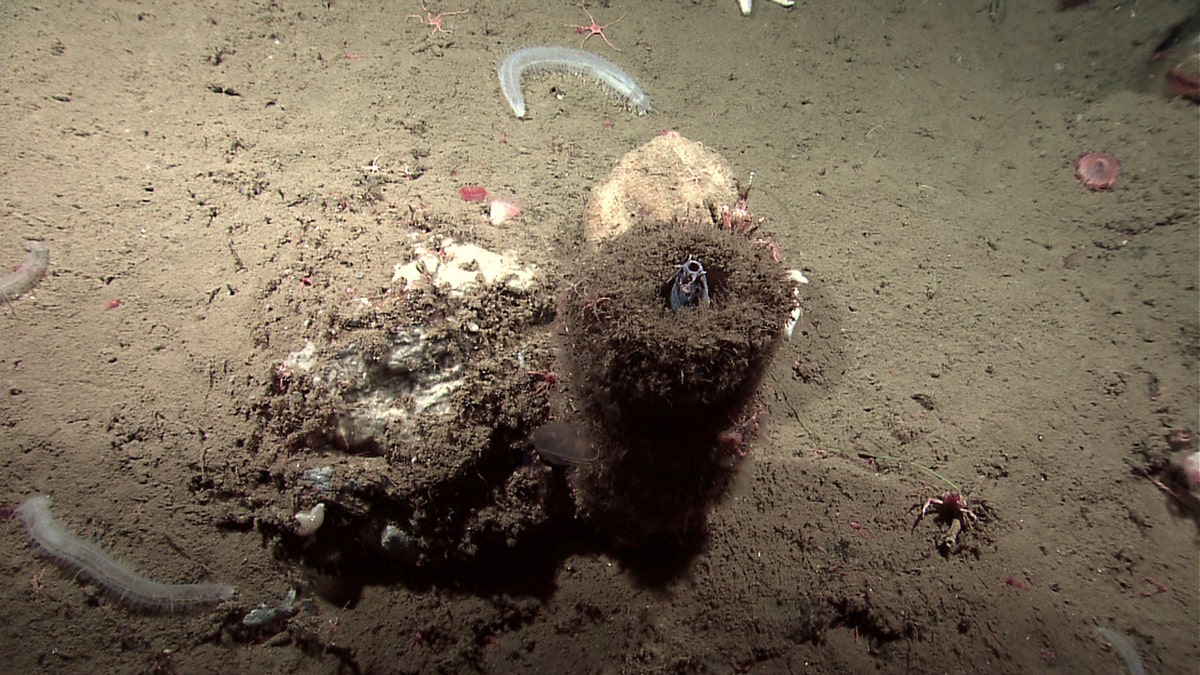
A hagfish protruding from a sponge. (Credit: NOAA Okeanos Explorer Program)
Older than the dinosaurs, slime from a primitive creature could be used for future bulletproof body armor.
The hagfish is more than 300 million years old and it lives out of sight in the deepest depths of the ocean. Without a jaw, this spineless ancient creature scavenges the ocean floor for food.
It feasts on dying animals from the inside out and although it is snakelike, hagfish do not have scales. To defend itself, the hagfish unleashes slime (similar to slime featured in "Ghostbusters") - and it is this slime that has military scientists excited.
WILL COMBAT VEHICLES USE URINE FOR FUEL?
Spider silk has long been pursued as an option to building ultralight weight and ultra-strong body armor. Hagfish slime threads are almost as strong and light as spider silk, but could prove far easier to harvest in the necessary large volumes to be practical.
Made of mucus and threadlike fibers, the clear slime’s fibers are ultra-strong and flexible.

A hagfish protruding from a sponge. (Credit: NOAA Okeanos Explorer Program)
Will synthetic slime become the basis of new body armor for the military? Bottled into a spray to protect Navy divers? Scientists are unlocking these and more potential from this unique fish.
Hagfish slime and its unique capabilities are being studied and pioneered by scientists like the Navy team at Naval Surface Warfare Center, Panama City Division in Florida.
Slime defense
Hagfish defend themselves by oozing slime on their threats, some of which risk slime suffocation.
When combined with seawater, the slime rapidly expands and creates huge volumes. One mere foot-long hagfish can possess hundreds of miles of slime thread inside and can expand 10,000 times in volume in milliseconds.
Even a shark attempting to eat a hagfish will find it hard to succeed and will battle a face and gills full of slime – risking slime suffocation.
To clean off their slime, hagfish tie themselves in knots.

(Credit: US Navy, Naval Surface Warfare Center Panama City Division)
How could it be used for body armor?
The slime is simple, but incredibly strong with very interesting properties with great defense potential.
When the wet fibers are stretched and dried out, the fibers become a sort of soft thread that could be woven to create a range of apparel materials.
Scientists believe that this hagfish slime, and its ultra-strong stretchy thread, could be the key to next-level bullet-proof vests.
Just how strong is hagfish slime? Hagfish may not be pretty, but they’ve got staying power and this is in large part down to its ability to defend itself and survive. The hagfish have been around for centuries during extinction after extinction - even outlasting the dinosaurs.
In fact, dinosaurs became extinct 60 million years ago, but hagfish date back 330 million years.
WILL A SINGLE BOMB STOP NORTH KOREA?
How will they farm slime?
Any team working to crack slime applications will need to figure out how to reproduce the slime and at high volumes.
Natural hagfish reproduction still remains a mystery. Hagfish breeding in captivity has not yielded success, therefore hagfish farms are an unlikely solution. Artificial reproduction in a lab is more probable.
Spider silk has been similarly pursued for its strength and posed similar practical problems in terms of replicating at a mass level. Hagfish slime proteins are smaller and so could prove easier to replicate.
Remarkably, the Navy team has already replicated the material and can now focus on applying the synthetic slime to provide military advantages.
Potential applications
Replicated slime could replace petroleum based-products like Kevlar. Similar to spider silk, there is potential it could eventually provide enhanced strength at a lighter weight than current bulletproof armor.
Beyond bulletproof vests, there are other interesting military applications.
For example, special operations could find creative tactical uses for a material that can instantly change, massively expand and ensnare or “clog.”
Different delivery systems are being explored. Just as the slime protects the fish, the synthetic slime could potentially be developed into a spray to protect divers against sharks.
An artificial slime also means that it can be tinkered with and modified. Scientists are working on enhancing the synthetic slime’s stickiness- its ability to attach to various surfaces. Enhancing the slime’s stability in different environments is another potential objective that would expand its potential utility for the military.
Another application could be applying the slime as a ship coating to prevent barnacles and algae from attaching.
On the homeland, there’s lots of other potential such as using the slime to protect firefighters.
What’s next?
Eventually, some products derived from the hagfish slime could work their way into uses outside of the military.
Scientists in the commercial space have been looking at using the slime to replace Lycra, spandex and nylon in regularly worn clothing and fabrics.




















